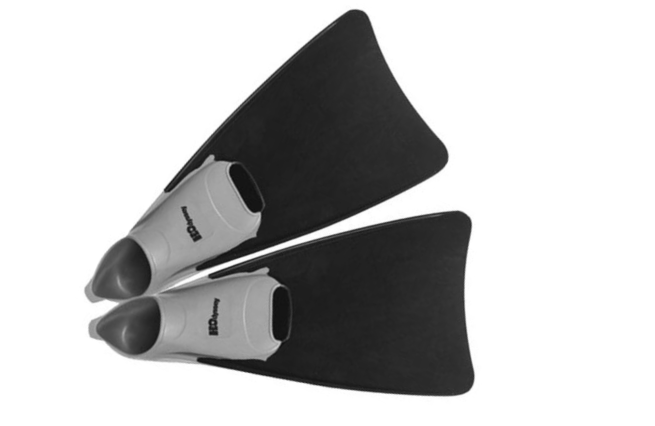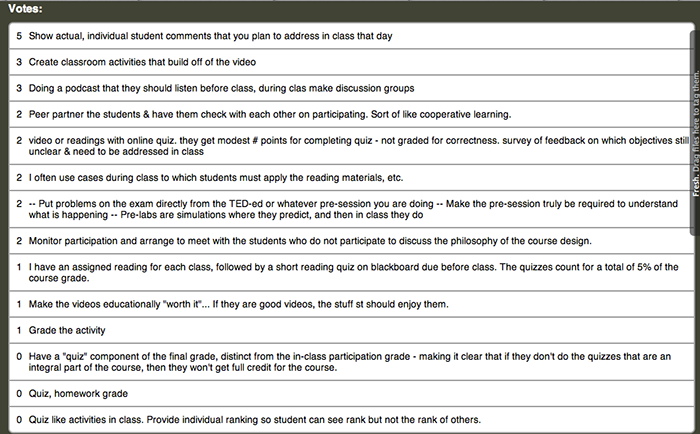Everybody’s Flippin’ —An Update on the Flipped Classroom

Background
The Boston University Center for Excellence and Innovation in Teaching (CEIT) offers a rich program of Teaching Talks (focused on pedagogy) and Teaching Tech Talks (focused on technology use). The Spring 2013 program included talks on course design, using learning management systems, group work in the classroom, etc. I was invited to host a CEIT Teaching Talk on the flipped classroom by Prof. Janelle Heineke, Faculty Director of CEIT and Chair of the Operations and Technology Management Department (BU School of Management). The Abstract and links to background materials that I submitted for the talk are copied below.
Flip the Talk
As I thought about what to say and how to say it, it hit me how incongruous it was to give a "lecture-style" talk on the flipped classroom. The very basis of the flipped pedagogy is that lectures are an ineffective teaching method; often lectures are not even an efficient communication method. My own presentation style is far from "death by PowerPoint", being image-heavy and message-focused, with influences including the design and presentation books by R. Wiliams1, and Garr Reynolds' Presentation Zen2. But that was not enough this time.
The premise of the flipped classroom is that the straightforward content delivery is moved outside the classroom—by means of readings, podcasts or video. Class time is then more effectively used in teacher-guided discussions that actively engage students, peer instruction activities, project-based learning, etc. So my problem was, how to flip the talk? How to engage my audience in a discussion, in which they would create the answers they were looking for in coming to this talk?
Using TED-Ed and Socrative
To start, I needed to provide some content for my audience to "come prepared" to the talk. I searched for a short video that would communicate the basic idea of the flipped classroom, and found a 2.5-minute feature of Eric Mazur (Harvard Univesity), a long-time proponent of peer instruction methods and self-declared converted lecturer.3 As I have learned, video is a convincing medium for content delivery, but it is a more effective teaching aid when paired with an online quiz and feedback system. Lately, I have been using the TED-Ed platform to create context and quizes around my videos, so I made a TED-Ed lesson for my flipped-class talk. It was announced by email to all the registered talk participants a week ahead of the talk and again the day before.
I included two open-ended questions in the TED-Ed quiz: are you likely to try the flipped classroom? and, what are your concerns or misgivings, or reasons to not try the flipped classroom approach? Like I expected, very few people actually entered their answers in the TED-Ed quiz. Responding to the second question, one of them wrote: "many students won't come prepared to class." This is a common concern with the flipped class, so I decided to start my talk with a discussion of this very issue. I also decided that, against all conventions, I would not begin by defining the flipped classroom—either the participants knew about it, and were interested enough to attend, or they should have watched the video! With this strategy, I made two points: (1) in a flipped class, if students don't come prepared, as blogger Robert Talbert says,4 "they're toast"; (2) addressing student online feedback in class encourages them to engage with the online aspect of the course.
So, I started my flipped talk by initiating a web-based "in-class response" via Socrative, with the True/False question "did you watch the video?" In a quick exercise of getting people online with their devices, joining my Socrative "room" and answering the question, we gathered that about 3/4 of the participants had watched the video. Good! But only three people had left answers in the TED-Ed lesson, which led to the discussion of the issue of students not coming prepared or not engaging with the online "homework". I explained my own strategies to alleviate this problem: monitor students' online work (e.g., via TED-Ed quizes) and assign participation points for it, and make sure to address their online feedback in class. I then initiated an open-ended Socrative question, asking for other ideas. After a dozen or so suggestions were submitted by the audience, I had them vote on them. Here is the screenshot of that exercise:
As the discussion proceeded—including one participant saying that she didn't have a clue what I was talking about, which I used as live demonstration of what happens when you don't come prepared to class!—I showed how I use tools like TED-Ed, Socrative, online video, the Attendance app (for creating random groups of students in class), etc. I also mentioned the Flipped Learning Network as a source of information for flipping your class, and I described how I make videos. My workflow for preparing videos uses:
- my Mac
- the iShowU app for screen recording
- a Wacom graphic tablet
- the OmniDazzle app for live screen annotations
- YouTube and iTunesU for distribution
- TED-Ed for context & quiz
Piazza and a surprise guest
I also use the social learning site Piazza for all my course communications, student Q&A, preparing course activities, and disseminating class materials. After showing several examples of how I use this platform to facilitate a flipped classroom, I had the pleasure to introduce a surprise guest: Pooja Sankar, the creator of Piazza, was visiting Boston and we had arranged for her to come to my Teaching Talk and answer questions about Piazza at the end of the session. A very animated conversation ensued, where Pooja took notes of some of the suggestions and requests from other Piazza users. (For example, Prof. Bennett Goldberg said he would be interested in having access to the database of student activity on the site and analytics of their usage.)
At the end of the one-hour-plus session, I asked the audience: "So, what is the flipped classroom?" An accurate and prompt reply came from the person who had said at the beginning of the hour that she hadn't a clue what I was talking about, and I think she and most everyone else was more confident with this approach than when we started. Perhaps just enough to encourage a few of them to flip their next class.
Screencast
- "Everybody's Flippin' —An update on the flipped classroom", L. A. Barba. (17 February 2013). 10.6084/m9.figshare.157200 // Blog post
Full-length video (screencast) from the talk, published on figshare under CC-BY
Notes
1 The Non-Designer's Design & Type Books (2007) and The Non-Designer's Presentation Book (2009), Robin Williams.
2 Presentation Zen: Simple Ideas on Presentation Design and Delivery, Garr Reynolds (2008) // Presentation Zen website
3 Confessions of a Converted Lecturer, a talk by Eric Mazur, available on You Tube
4 What kind of student preparation should we care about?, blog post by Robert Talbert, Casting Out Nines, The Chronicle of Higher Education (Oct. 11, 2012)
Everybody’s Flippin’ — An Update on the Flipped Classroom
BU CEIT Teaching Talk by Lorena A. Barba, College of Engineering Wednesday, 13 February 2013, 12:00-1:15 pmAbstract:
A big driver for the flipped classroom has been the availability of online videos and the growth of broadband Internet. It is important not to conflate videos with a flipped class, however. The idea of flipping the classroom is simply to move the transfer of content to the asynchronous “home work” and use class time for embedding knowledge through problem-solving (the old homework) and engaging activities. The effectiveness of interactive engagement, compared with passive-student lecture methods, is now supported by plenty of evidence. So how do you flip? Pre-classroom videos are now easy to produce or re-use from a variety of sources (You Tube, MIT OCW, Khan Academy, etc.), so they have become a popular flip aid. The bigger question is, what you do in class? We will discuss examples and stories, which I will bring from my own experience, blogs and publications
Background:
- My essay about flipping my first class, on spring 2012
- “Flip teaching” wiki entry
- Wired magazine feature on Salman Khan
- The Flipped Class Manifest
